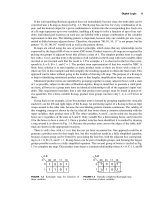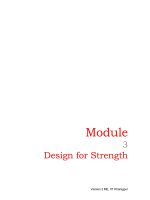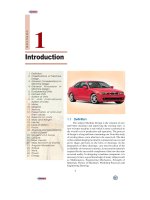The Algorithm Design Manual Next: Preface Up Main PageThe Algorithm Design ManualSteven docx
Bạn đang xem bản rút gọn của tài liệu. Xem và tải ngay bản đầy đủ của tài liệu tại đây (14.05 MB, 1,766 trang )
The Algorithm Design Manual
Next:
Preface Up: Main Page
The Algorithm Design
Manual
Steven S. Skiena
Department of Computer Science
State University of New York
Stony Brook, NY 11794-4400
Copyright © 1997 by Springer-Verlag, New York
● Contents
● Techniques
❍ Introduction to Algorithms
❍ Data Structures and Sorting
❍ Breaking Problems Down
❍ Graph Algorithms
❍ Combinatorial Search and Heuristic Methods
❍ Intractable Problems and Approximations
❍ How to Design Algorithms
● Resources
❍ A Catalog of Algorithmic Problems
❍ Algorithmic Resources
● References
● Index
● About this document
file:///E|/BOOK/BOOK/BOOK.HTM (1 of 2) [19/1/2003 1:27:29]
The Algorithm Design Manual
Algorithms
Mon Jun 2 23:33:50 EDT 1997
file:///E|/BOOK/BOOK/BOOK.HTM (2 of 2) [19/1/2003 1:27:30]
Preface
Next:
Acknowledgments Up: The Algorithm Design Manual Previous: The Algorithm Design Manual
Preface
Most of the professional programmers that I've encountered are not well prepared to tackle algorithm
design problems. This is a pity, because the techniques of algorithm design form one of the core practical
technologies of computer science. Designing correct, efficient, and implementable algorithms for real-
world problems is a tricky business, because the successful algorithm designer needs access to two
distinct bodies of knowledge:
● Techniques - Good algorithm designers understand several fundamental algorithm design
techniques, including data structures, dynamic programming, depth-first search, backtracking, and
heuristics. Perhaps the single most important design technique is modeling, the art of abstracting a
messy real-world application into a clean problem suitable for algorithmic attack.
● Resources - Good algorithm designers stand on the shoulders of giants. Rather than laboring from
scratch to produce a new algorithm for every task, they know how to find out what is known
about a particular problem. Rather than reimplementing popular algorithms from scratch, they
know where to seek existing implementations to serve as a starting point. They are familiar with a
large set of basic algorithmic problems, which provides sufficient source material to model most
any application.
This book is intended as a manual on algorithm design, providing access to both aspects of combinatorial
algorithms technology for computer professionals and students. Thus this book looks considerably
different from other books on algorithms. Why?
● We reduce the design process to a sequence of questions to ask about the problem at hand. This
provides a concrete path to take the nonexpert from an initial problem statement to a reasonable
solution.
● Since the practical person is usually looking for a program more than an algorithm, we provide
pointers to solid implementations whenever they are available. We have collected these
implementations on the enclosed CD-ROM and at one central FTP/WWW site for easy retrieval.
Further, we provide recommendations to make it easier to identify the correct code for the job.
With these implementations available, the critical issue in algorithm design becomes properly
modeling your application, more so than becoming intimate with the details of the actual
algorithm. This focus permeates the entire book.
● Since finding out what is known about a problem can be a difficult task, we provide a catalog of
important algorithmic problems as a major component of this book. By browsing through this
file:///E|/BOOK/BOOK/NODE1.HTM (1 of 3) [19/1/2003 1:27:32]
Preface
catalog, the reader can quickly identify what their problem is called, what is known about it, and
how they should proceed to solve it. To aid in problem identification, we include a pair of
``before'' and ``after'' pictures for each problem, illustrating the required input and output
specifications.
● For each problem in the catalog, we provide an honest and convincing motivation, showing how it
arises in practice. If we could not find such an application, then the problem doesn't appear in this
book.
● In practice, algorithm problems do not arise at the beginning of a large project. Rather, they
typically arise as subproblems when it suddenly becomes clear that the programmer does not
know how to proceed or that the current program is inadequate. To provide a better perspective on
how algorithm problems arise in the real world, we include a collection of ``war stories,'' tales
from our experience on real problems. The moral of these stories is that algorithm design and
analysis is not just theory, but an important tool to be pulled out and used as needed.
Equally important is what we do not do in this book. We do not stress the mathematical analysis of
algorithms, leaving most of the analysis as informal arguments. You will not find a single theorem
anywhere in this book. Further, we do not try to be encyclopedic in our descriptions of algorithms, but
only in our pointers to descriptions of algorithms. When more details are needed, the reader should
follow the given references or study the cited programs. The goal of this manual is to get you going in
the right direction as quickly as possible.
But what is a manual without software? This book comes with a substantial electronic supplement, an
ISO-9660 compatible, multiplatform CD-ROM, which can be viewed using Netscape, Microsoft
Explorer, or any other WWW browser. This CD-ROM contains:
● A complete hypertext version of the full printed book. Indeed, the extensive cross-references
within the book are best followed using the hypertext version.
● The source code and URLs for all cited implementations, mirroring the Stony Brook Algorithm
Repository WWW site. Programs in C, C++, Fortran, and Pascal are included, providing an
average of four different implementations for each algorithmic problem.
● More than ten hours of audio lectures on the design and analysis of algorithms are provided, all
keyed to the on-line lecture notes. Following these lectures provides another approach to learning
algorithm design techniques. These notes are linked to an additional twenty hours of audio over
the WWW. Listening to all the audio is analogous to taking a one-semester college course on
algorithms!
This book is divided into two parts, techniques and resources. The former is a general guide to
techniques for the design and analysis of computer algorithms. The resources section is intended for
browsing and reference, and comprises the catalog of algorithmic resources, implementations, and an
extensive bibliography.
Altogether, this book covers material sufficient for a standard Introduction to Algorithms course, albeit
file:///E|/BOOK/BOOK/NODE1.HTM (2 of 3) [19/1/2003 1:27:32]
Preface
one stressing design over analysis. We assume the reader has completed the equivalent of a second
programming course, typically titled Data Structures or Computer Science II. Textbook-oriented features
include:
● In addition to standard pen-and-paper exercises, this book includes ``implementation challenges''
suitable for teams or individual students. These projects and the applied focus of the text can be
used to provide a new laboratory focus to the traditional algorithms course. More difficult
exercises are marked by (*) or (**).
● ``Take-home lessons'' at the beginning of each chapter emphasize the concepts to be gained from
the chapter.
● This book stresses design over analysis. It is suitable for both traditional lecture courses and the
new ``active learning'' method, where the professor does not lecture but instead guides student
groups to solve real problems. The ``war stories'' provide an appropriate introduction to the active
learning method.
● A full set of lecture slides for teaching this course is available on the CD-ROM and via the World
Wide Web, both keyed to unique on-line audio lectures covering a full-semester algorithm course.
Further, a complete set of my videotaped lectures using these slides is available for interested
parties. See algorith for details.
Next:
Acknowledgments Up: The Algorithm Design Manual Previous: The Algorithm Design Manual
Algorithms
Mon Jun 2 23:33:50 EDT 1997
file:///E|/BOOK/BOOK/NODE1.HTM (3 of 3) [19/1/2003 1:27:32]
Acknowledgments
Next:
Caveat Up: The Algorithm Design Manual Previous: Preface
Acknowledgments
I would like to thank several people for their concrete contributions to this project. Ricky Bradley built
up the substantial infrastructure required for both the WWW site and CD-ROM in a logical and
extensible manner. Zhong Li did a spectacular job drawing most of the catalog figures using xfig and
entering the lecture notes that served as the foundation of Part I of this book. Frank Ruscica, Kenneth
McNicholas and Dario Vlah all came up big in the pinch, redoing all the audio and helping as the
completion deadline approached. Filip Bujanic, David Ecker, David Gerstl, Jim Klosowski, Ted Lin,
Kostis Sagonas, Kirsten Starcher, Brian Tria, and Lei Zhao all made contributions at various stages of the
project.
Richard Crandall, Ron Danielson, Takis Metaxas, Dave Miller, Giri Narasimhan, and Joe Zachary all
reviewed preliminary versions of the manuscript and/or CD-ROM; their thoughtful feedback helped to
shape what you see here. Thanks also to Allan Wylde, the editor of my previous book as well as this one,
and Keisha Sherbecoe and Robert Wexler of Springer-Verlag.
I learned much of what I know about algorithms along with my graduate students Yaw-Ling Lin,
Sundaram Gopalakrishnan, Ting Chen, Francine Evans, Harald Rau, Ricky Bradley, and Dimitris
Margaritis. They are the real heroes of many of the war stories related within. Much of the rest I have
learned with my Stony Brook friends and colleagues Estie Arkin and Joe Mitchell, who have always
been a pleasure to work and be with.
Finally, I'd like to send personal thanks to several people. Mom, Dad, Len, and Rob all provided moral
support. Michael Brochstein took charge of organizing my social life, thus freeing time for me to actually
write the book. Through his good offices I met Renee. Her love and patience since then have made it all
worthwhile.
Next: Caveat Up: The Algorithm Design Manual Previous: Preface
Algorithms
file:///E|/BOOK/BOOK/NODE2.HTM (1 of 2) [19/1/2003 1:27:33]
Acknowledgments
Mon Jun 2 23:33:50 EDT 1997
file:///E|/BOOK/BOOK/NODE2.HTM (2 of 2) [19/1/2003 1:27:33]
Caveat
Next:
Contents Up: The Algorithm Design Manual Previous: Acknowledgments
Caveat
It is traditional for the author to magnanimously accept the blame for whatever deficiencies remain. I
don't. Any errors, deficiencies, or problems in this book are somebody else's fault, but I would appreciate
knowing about them so as to determine who is to blame.
Steven S. Skiena Department of Computer Science State University of New York Stony Brook, NY
11794-4400
skiena May 1997
Algorithms
Mon Jun 2 23:33:50 EDT 1997
file:///E|/BOOK/BOOK/NODE3.HTM [19/1/2003 1:27:33]
Contents
Next: Techniques Up: The Algorithm Design Manual Previous: Caveat
Contents
● Techniques
❍ Introduction to Algorithms
■ Correctness and Efficiency
■ Correctness
■ Efficiency
■ Expressing Algorithms
■ Keeping Score
■ The RAM Model of Computation
■ Best, Worst, and Average-Case Complexity
■ The Big Oh Notation
■ Growth Rates
■ Logarithms
■ Modeling the Problem
■ About the War Stories
■ War Story: Psychic Modeling
■ Exercises
❍ Data Structures and Sorting
■ Fundamental Data Types
■ Containers
■ Dictionaries
■ Binary Search Trees
■ Priority Queues
■ Specialized Data Structures
■ Sorting
■ Applications of Sorting
■ Approaches to Sorting
■ Data Structures
■ Incremental Insertion
■ Divide and Conquer
■ Randomization
■ Bucketing Techniques
■ War Story: Stripping Triangulations
file:///E|/BOOK/BOOK/NODE4.HTM (1 of 7) [19/1/2003 1:27:35]
Contents
■ War Story: Mystery of the Pyramids
■ War Story: String 'em Up
■ Exercises
❍ Breaking Problems Down
■ Dynamic Programming
■ Fibonacci numbers
■ The Partition Problem
■ Approximate String Matching
■ Longest Increasing Sequence
■ Minimum Weight Triangulation
■ Limitations of Dynamic Programming
■ War Story: Evolution of the Lobster
■ War Story: What's Past is Prolog
■ War Story: Text Compression for Bar Codes
■ Divide and Conquer
■ Fast Exponentiation
■ Binary Search
■ Square and Other Roots
■ Exercises
❍ Graph Algorithms
■ The Friendship Graph
■ Data Structures for Graphs
■ War Story: Getting the Graph
■ Traversing a Graph
■ Breadth-First Search
■ Depth-First Search
■ Applications of Graph Traversal
■ Connected Components
■ Tree and Cycle Detection
■ Two-Coloring Graphs
■ Topological Sorting
■ Articulation Vertices
■ Modeling Graph Problems
■ Minimum Spanning Trees
■ Prim's Algorithm
■ Kruskal's Algorithm
■ Shortest Paths
■ Dijkstra's Algorithm
file:///E|/BOOK/BOOK/NODE4.HTM (2 of 7) [19/1/2003 1:27:35]
Contents
■ All-Pairs Shortest Path
■ War Story: Nothing but Nets
■ War Story: Dialing for Documents
■ Exercises
❍ Combinatorial Search and Heuristic Methods
■ Backtracking
■ Constructing All Subsets
■ Constructing All Permutations
■ Constructing All Paths in a Graph
■ Search Pruning
■ Bandwidth Minimization
■ War Story: Covering Chessboards
■ Heuristic Methods
■ Simulated Annealing
■ Traveling Salesman Problem
■ Maximum Cut
■ Independent Set
■ Circuit Board Placement
■ Neural Networks
■ Genetic Algorithms
■ War Story: Annealing Arrays
■ Parallel Algorithms
■ War Story: Going Nowhere Fast
■ Exercises
❍ Intractable Problems and Approximations
■ Problems and Reductions
■ Simple Reductions
■ Hamiltonian Cycles
■ Independent Set and Vertex Cover
■ Clique and Independent Set
■ Satisfiability
■ The Theory of NP-Completeness
■ 3-Satisfiability
■ Difficult Reductions
■ Integer Programming
■ Vertex Cover
■ Other NP-Complete Problems
■ The Art of Proving Hardness
file:///E|/BOOK/BOOK/NODE4.HTM (3 of 7) [19/1/2003 1:27:35]
Contents
■ War Story: Hard Against the Clock
■ Approximation Algorithms
■ Approximating Vertex Cover
■ The Euclidean Traveling Salesman
■ Exercises
❍ How to Design Algorithms
● Resources
❍ A Catalog of Algorithmic Problems
■ Data Structures
■ Dictionaries
■ Priority Queues
■ Suffix Trees and Arrays
■ Graph Data Structures
■ Set Data Structures
■ Kd-Trees
■ Numerical Problems
■ Solving Linear Equations
■ Bandwidth Reduction
■ Matrix Multiplication
■ Determinants and Permanents
■ Constrained and Unconstrained Optimization
■ Linear Programming
■ Random Number Generation
■ Factoring and Primality Testing
■ Arbitrary-Precision Arithmetic
■ Knapsack Problem
■ Discrete Fourier Transform
■ Combinatorial Problems
■ Sorting
■ Searching
■ Median and Selection
■ Generating Permutations
■ Generating Subsets
■ Generating Partitions
■ Generating Graphs
■ Calendrical Calculations
■ Job Scheduling
■ Satisfiability
file:///E|/BOOK/BOOK/NODE4.HTM (4 of 7) [19/1/2003 1:27:35]
Contents
■ Graph Problems: Polynomial-Time
■ Connected Components
■ Topological Sorting
■ Minimum Spanning Tree
■ Shortest Path
■ Transitive Closure and Reduction
■ Matching
■ Eulerian Cycle / Chinese Postman
■ Edge and Vertex Connectivity
■ Network Flow
■ Drawing Graphs Nicely
■ Drawing Trees
■ Planarity Detection and Embedding
■ Graph Problems: Hard Problems
■ Clique
■ Independent Set
■ Vertex Cover
■ Traveling Salesman Problem
■ Hamiltonian Cycle
■ Graph Partition
■ Vertex Coloring
■ Edge Coloring
■ Graph Isomorphism
■ Steiner Tree
■ Feedback Edge/Vertex Set
■ Computational Geometry
■ Robust Geometric Primitives
■ Convex Hull
■ Triangulation
■ Voronoi Diagrams
■ Nearest Neighbor Search
■ Range Search
■ Point Location
■ Intersection Detection
■ Bin Packing
■ Medial-Axis Transformation
■ Polygon Partitioning
■ Simplifying Polygons
file:///E|/BOOK/BOOK/NODE4.HTM (5 of 7) [19/1/2003 1:27:35]
Contents
■ Shape Similarity
■ Motion Planning
■ Maintaining Line Arrangements
■ Minkowski Sum
■ Set and String Problems
■ Set Cover
■ Set Packing
■ String Matching
■ Approximate String Matching
■ Text Compression
■ Cryptography
■ Finite State Machine Minimization
■ Longest Common Substring
■ Shortest Common Superstring
❍ Algorithmic Resources
■ Software systems
■ LEDA
■ Netlib
■ Collected Algorithms of the ACM
■ The Stanford GraphBase
■ Combinatorica
■ Algorithm Animations with XTango
■ Programs from Books
■ Discrete Optimization Algorithms in Pascal
■ Handbook of Data Structures and Algorithms
■ Combinatorial Algorithms for Computers and Calculators
■ Algorithms from P to NP
■ Computational Geometry in C
■ Algorithms in C++
■ Data Sources
■ Textbooks
■ On-Line Resources
■ Literature
■ People
■ Software
■ Professional Consulting Services
● References
● Index
file:///E|/BOOK/BOOK/NODE4.HTM (6 of 7) [19/1/2003 1:27:35]
Contents
● About this document
Algorithms
Mon Jun 2 23:33:50 EDT 1997
file:///E|/BOOK/BOOK/NODE4.HTM (7 of 7) [19/1/2003 1:27:35]
Index
Next: About this document Up: The Algorithm Design Manual Previous: References
Index
This index provides fast access to important keywords and topics in the on-line Book. The menu below
partitions the index entries by the first letter of the alphabet, for ease of access. A full document index is
also provided.
Be aware that the index pointer typically resides at the end of the relevant paragraph in the document, so
we recommend scrolling once towards the front of the document before reading.
A similar
index has been provided for the Lecture Notes, which may also be of interest.
A B C D E F G H
I J K L M N O P
Q R S T U V W X
Y Z
Complete Index
(note: the complete index is large; it will take a bit of time to load)
Algorithms
Mon Jun 2 23:33:50 EDT 1997
file:///E|/BOOK/BOOK5/NODE233.HTM [19/1/2003 1:27:36]
The Algorithm Design Manual
The Algorithm Design Manual
The CD-ROM
Steven S. Skiena
Department of Computer Science
State University of New York
Stony Brook, NY 11794-4400
What is a manual without software? The electronic supplement to this book is a ISO-9660 compatible,
multiplatform CD-ROM, which can be viewed using Netscape, Microsoft Explorer, or any other WWW
browser. This CD-ROM contains:
● The Algorithm Design Manual: Hypertext Edition A complete hypertext version of the full printed book.
Indeed, the extensive cross-references within the book are best followed using the hypertext version.
● The Algorithm Repository Website The source code and URLs for all cited implementations,
mirroring the Stony Brook Algorithm Repository WWW site. Programs in C, C++, Fortran, and Pascal
are included, providing an average of four different implementations for each algorithmic problem.
● Algorithms Lectures More than 30 hours of audio lectures on the design and analysis of algorithms are
provided, all keyed to on-line lecture notes. Following these lectures provides another approach to
learning algorithm design techniques. Listening to all the audio is analogous to taking a one-semester
file:///E|/INDEX.HTM (1 of 2) [19/1/2003 1:27:37]
The Algorithm Design Manual
college course on algorithms!
● Bibliographic References Pointers to the net's most important collections of references on algorithms.
Local copies of two large bibliographies are included.
● About the Book
● Copyright Notice and Disclaimers
● Graphics Gallery
● Send us Mail
● Guide to Configuring Browsers
● Thanks!
file:///E|/INDEX.HTM (2 of 2) [19/1/2003 1:27:37]
Lecture Notes Analysis of Algorithms
CSE 373/548 - Analysis of Algorithms
Lecture Notes with Audio
Steven Skiena
Department of Computer Science
SUNY Stony Brook
In Spring 1996, I taught my Analysis of Algorithms
course via EngiNet, the SUNY Stony Brook distance
learning program. Each of my lectures that semester was
videotaped, and the tapes made available to off-site
students. I found it an enjoyable experience.
As an experiment in using the Internet for distance
learning, we have digitized the complete audio of all 23
lectures, and have made this available on the WWW. We
partitioned the full audio track into sound clips, each
corresponding to one page of lecture notes, and linked
them to the associated text.
In a real sense, listening to all the audio is analogous to sitting through a one-semester college course on
algorithms! Properly compressed, the full semester's audio requires less than 300 megabytes of storage,
which is much less than I would have imagined. The entire semesters lectures, over thirty hours of audio
files, fit comfortably on
The Algorithm Design Manual CD-ROM, which also includes a hypertext
version of the book and a substantial amount of software. All exercise numbers refer to Corman,
Leiserson, and Rivest's Introduction to Algorithms, the textbook I used that particular year.
The sound quality is amazingly good, considering it was me that they were taping. Unfortunately, the
Shockwave format we used is only supported under Windows and Macintoshes, so the sound cannot be
heard under UNIX. On certain browsers, a new window is opened for each sound bite, so be sure to close
these windows before they cause trouble.
Because of space requirements, we did not digitize much of the corresponding video, which would have
made the presentation even more interesting. Still, I hope you find that these audio lectures expand your
understanding of both algorithm design and educational multimedia. The full
video tapes themselves are
also available.
● Postscript lecture transparencies
file:///E|/LEC/LECTURES/ALL.HTM (1 of 3) [19/1/2003 1:27:38]
Lecture Notes Analysis of Algorithms
● A Guide to Configuring Browsers
● Binary Search Animation
● Other Algorithms Courses
Links To Individual Lectures
● Lecture 1 - analyzing algorithms
● Lecture 2 - asymptotic notation
● Lecture 3 - recurrence relations
● Lecture 4 - heapsort
● Lecture 5 - quicksort
● Lecture 6 - linear sorting
● Lecture 7 - elementary data structures
● Lecture 8 - binary trees
● Lecture 9 - catch up
● Lecture 10 - tree restructuring
● Lecture 11 - backtracking
● Lecture 12 - introduction to dynamic programming
● Lecture 13 - dynamic programming applications
● Lecture 14 - data structures for graphs
● Lecture 15 - DFS and BFS
● Lecture 16 - applications of DFS and BFS
● Lecture 17 - minimum spanning trees
● Lecture 18 - shortest path algorthms
● Lecture 19 - satisfiability
● Lecture 20 - integer programming
● Lecture 21 - vertex cover
● Lecture 22 - techniques for proving hardness
● Lecture 23 - approximation algorithms and Cook's theorem
● Index
● About this document
Next: Lecture 1 - analyzing Up: Main Page
file:///E|/LEC/LECTURES/ALL.HTM (2 of 3) [19/1/2003 1:27:38]
Lecture Notes Analysis of Algorithms
Algorithms
Mon Jun 2 09:21:39 EDT 1997
file:///E|/LEC/LECTURES/ALL.HTM (3 of 3) [19/1/2003 1:27:38]
The Stony Brook Algorithm Repository
The Stony Brook Algorithm Repository
Steven S. Skiena
Department of Computer Science
State University of New York
Stony Brook, NY 11794-4400
This WWW page is intended to serve as a comprehensive collection of algorithm implementations for
over seventy of the most fundamental problems in combinatorial algorithms. The problem taxonomy,
implementations, and supporting material are all drawn from my book The Algorithm Design Manual .
Since the practical person is more often looking for a program than an algorithm, we provide pointers to
solid implementations of useful algorithms, when they are available.
Because of the volatility of the WWW, we provide local copies for many of the implementations. We
encourage you to get them from the original sites instead of Stony Brook, because the version on the
original site is more likely to be maintained. Further, there are often supporting files and documentation
which we did not copy, and which may be of interest to you. The local copies of large implementations
are maintained as gzip tar archives and, where available, DOS zip archives. Software for decoding these
formats is readily available .
Many of these codes have been made available for research or educational use, although commercial use
requires a licensing arrangement with the author. Licensing terms from academic institutions are usually
surprisingly modest. The recognition that industry is using a particular code is important to the authors,
often more important than the money. This can lead to enhanced support or future releases of the
software. Do the right thing and get a license information about terms or who to contact is usually
available embedded within the documentation, or available at the original source site.
Use at your own risk. The author and Springer-Verlag make no representations, express or implied, with
respect to any software or documentation we describe. The author and Springer-Verlag shall in no event
be liable for any indirect, incidental, or consequential damages.
file:///E|/WEBSITE/INDEX.HTM (1 of 3) [19/1/2003 1:27:40]
The Stony Brook Algorithm Repository
About the Book Graphics Gallery Graphic Index
Audio Algorithm Lectures Bibliography References Data Sources
About the Ratings Copyright Notice and Disclaimers Top-Level CD-ROM Page
Problems by Category
● 1.1 Data Structures
● 1.2 Numerical Problems
● 1.3 Combinatorial Problems
● 1.4 Graph Problems polynomial-time problems
● 1.5 Graph Problems hard problems
● 1.6 Computational Geometry
● 1.7 Set and String Problems
Implementations By Language
● C++ Language Implementations
● C Language Implementations
● Pascal Language Implementations
● FORTRAN Language Implementations
● Mathematica Language Implementations
● Lisp Language Implementations
Other information on this site
● Order the Book
● Most Wanted List
● Tools and Utilities
● Repository Citations
● Video tapes
● Feedback
● Thanks!
file:///E|/WEBSITE/INDEX.HTM (2 of 3) [19/1/2003 1:27:40]
The Stony Brook Algorithm Repository
Send us mail
Web-site regenerated on Tue Jun 03, 1997
file:///E|/WEBSITE/INDEX.HTM (3 of 3) [19/1/2003 1:27:40]
Techniques
Next:
Introduction to Algorithms Up: The Algorithm Design Manual Previous: Contents
Techniques
● Introduction to Algorithms
❍ Correctness and Efficiency
❍ Expressing Algorithms
❍ Keeping Score
❍ The Big Oh Notation
❍ Growth Rates
❍ Logarithms
❍ Modeling the Problem
❍ About the War Stories
❍ War Story: Psychic Modeling
❍ Exercises
● Data Structures and Sorting
❍ Fundamental Data Types
❍ Specialized Data Structures
❍ Sorting
❍ Applications of Sorting
❍ Approaches to Sorting
❍ War Story: Stripping Triangulations
❍ War Story: Mystery of the Pyramids
❍ War Story: String 'em Up
❍ Exercises
● Breaking Problems Down
❍ Dynamic Programming
❍ Limitations of Dynamic Programming
❍ War Story: Evolution of the Lobster
❍ War Story: What's Past is Prolog
❍ War Story: Text Compression for Bar Codes
file:///E|/BOOK/BOOK/NODE5.HTM (1 of 3) [19/1/2003 1:27:41]









